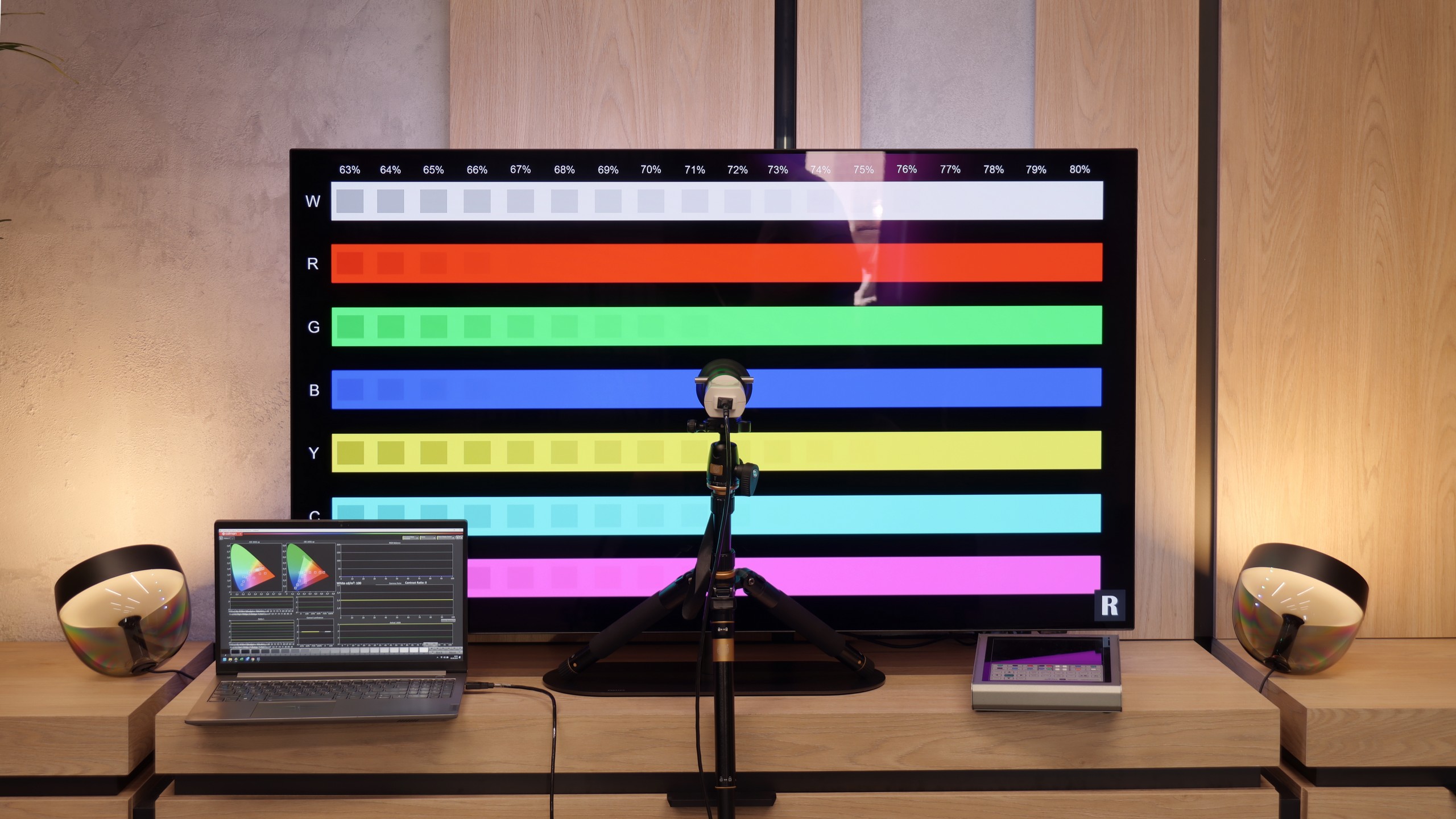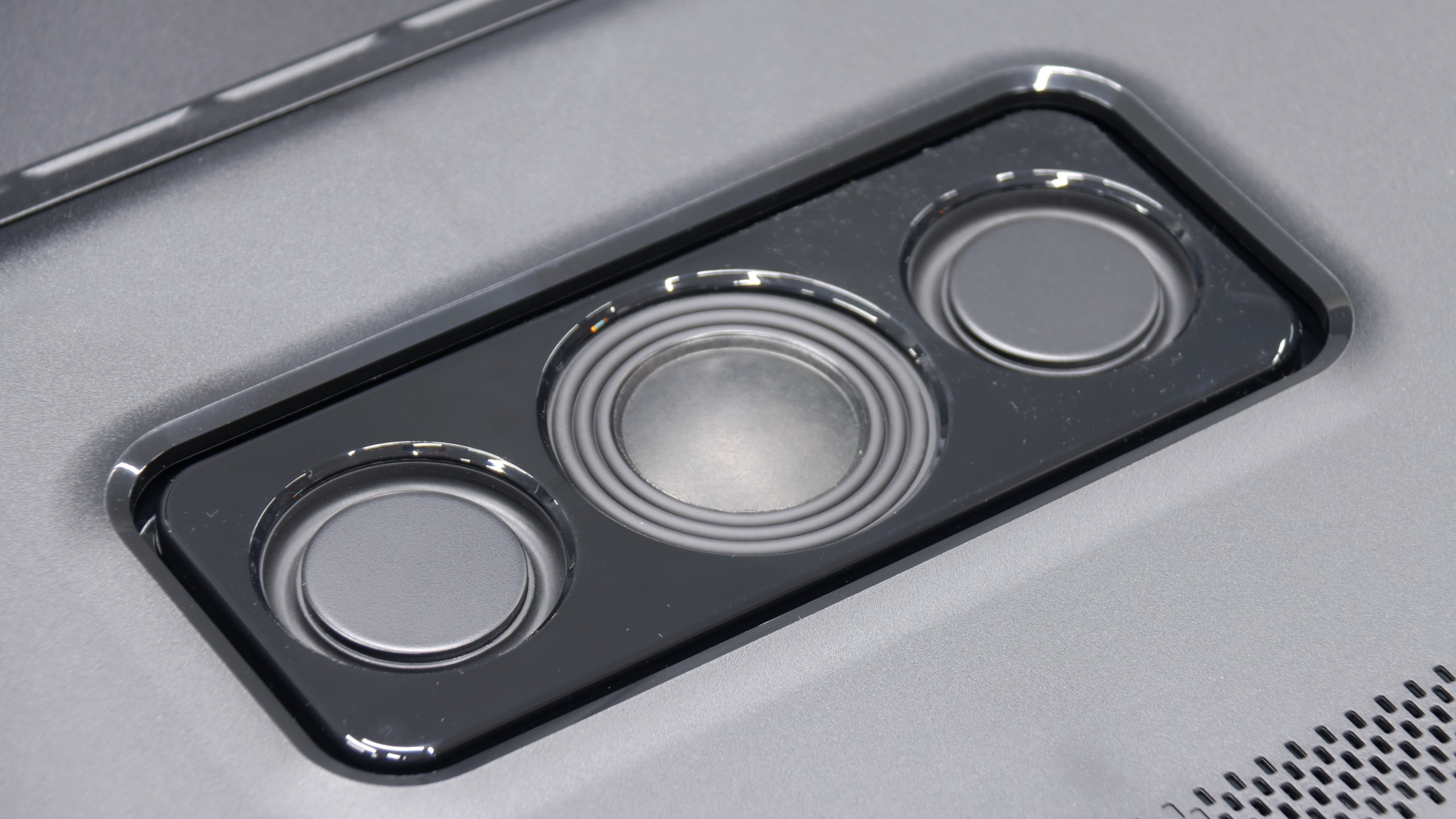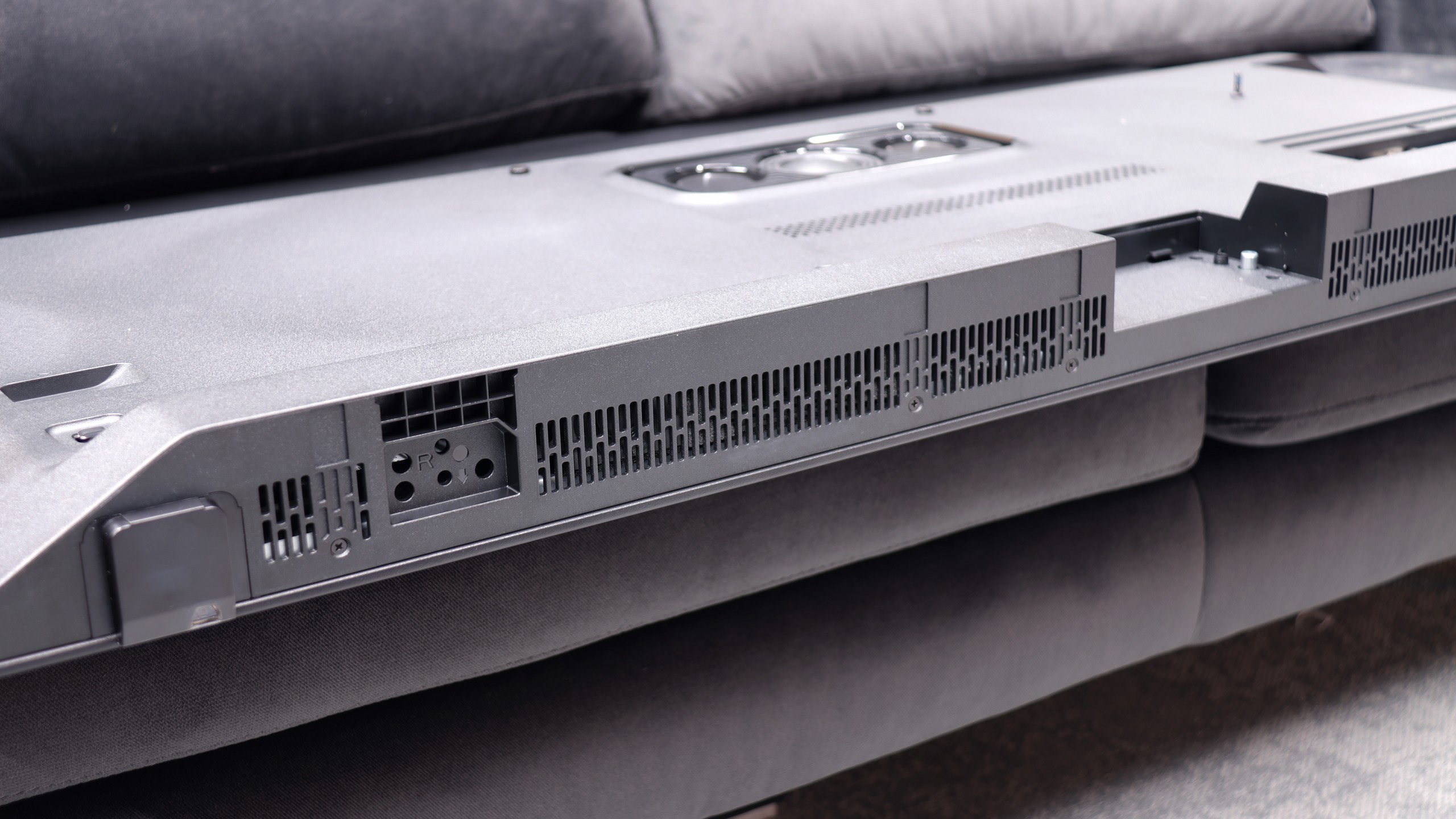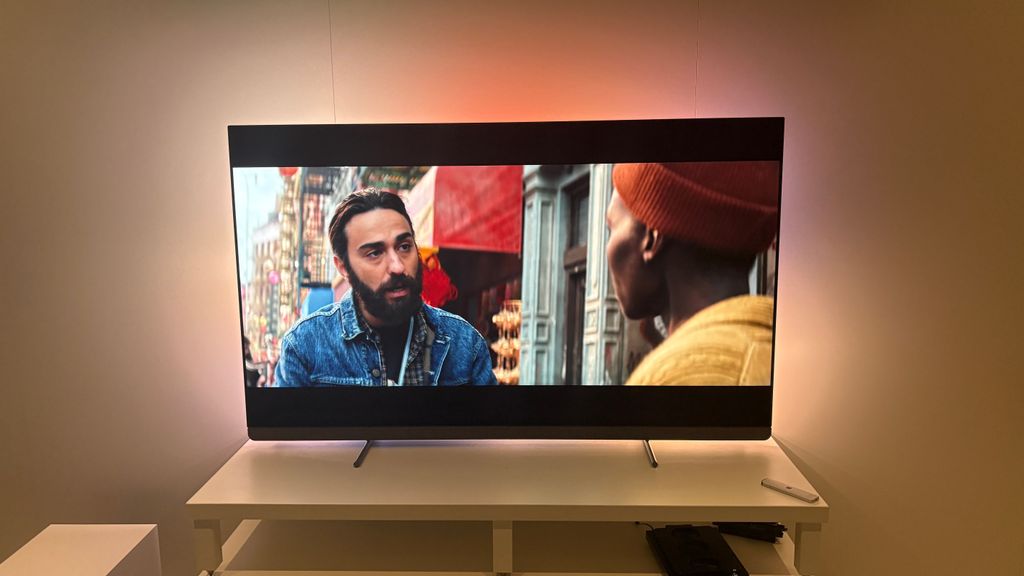- Matching (Score)
- Our verdict
- Competing TVs
- TV appearance
- Where to buy
- Contrast and black detail
- HDR effect quality
- Factory color reproduction
- Color reproduction after calibration
- Smoothness of tonal transitions
- Image scaling and smoothness of tonal transitions
- Blur and motion smoothness
- Console compatibility and gaming features
- Input lag
- Compatibility with PC
- Viewing angles
- TV efficiency during daytime
- TV features
- Apps
- Playing files from USB
- Sound
- Details about the matrix
Philips OLED820 Review
Available screen sizes:

Complete the survey to find out the result
Panel type: WRGB OLED Refresh rate: 144Hz Brand: PHILIPS Resolution: 3810x2160 System: Google TV Model year: 2025
In the world of televisions, it's easy to get lost, as most of them look like twins. The same parameters, the same slogans about cinematic quality and refresh rates, which are supposed to ensure the highest quality image. After a while, one begins to wonder if there is really anything left that can surprise. The Philips OLED820 on paper has everything that the competition offers, but adds its distinctive feature – Ambilight, which is a multicoloured backlighting that spreads behind the screen. However, that's just part of the story, as what truly matters in a television is the whole package: picture quality, HDR, smoothness, and everyday user comfort. We decided to check all of this to see if the OLED820 truly deserves your attention.

PHILIPS OLED820 - Our verdict
8.0
Overall rating
Philips OLED820 is a very successful and significant step forward compared to last year's model, the OLED 819. For many people, the main reason for purchase will, of course, be Ambilight: the multi-coloured lighting system that distinguishes Philips televisions from the competition. It's not hard to see why, as it made a huge impression on us as well. It's not just an impressive gadget, but a real addition that can transform the experience of the content being viewed and add depth to it. However, Ambilight should not overshadow what the OLED820 offers as a screen. We have almost infinite contrast, high brightness in HDR films, and excellent colour reproduction, which improves even further after slight tweaking or professional calibration. This set guarantees one of the best images that can currently be found on the market, and on top of that, we are aware that the television offers something unique and unattainable anywhere else. It is also a device that performs well in gaming. The 144 Hz panel and HDMI 2.1 ports open up access to the full potential of next-generation consoles, and the low input lag ensures that gameplay is exceptionally responsive. The operating system – Google TV – also deserves praise. It is a much better solution than the proprietary Titan OS found in lower models of Philips, such as the OLED770. This is a serious argument for paying extra for this model. A larger library of applications, a more efficient voice assistant, and fewer system errors translate into a distinctly better daily experience. Of course, the Philips OLED 820 is not free from minor flaws – there are some shortcomings in the software, and certain functions could be better refined. Nevertheless, the overall presentation is very solid. Perhaps the OLED820 is not a revolutionary television, but it is a very successful and well-balanced proposition in Philips's offering. It combines excellent image quality, a full set of functions for gamers, and a unique addition in the form of Ambilight. If you are looking for a solid OLED in the mid-range that, aside from good image quality, offers something distinctive and simultaneously exceptional, the OLED820 should be high on your shopping list.
Advantages
Ideal contrast and black thanks to the WOLED panel
High HDR brightness (up to 1300 nits) and wide coverage of the DCI-P3 colour palette (99%)
Support for multiple HDR formats including Dolby Vision and HDR10+
Great motion smoothness, no motion blur, refresh rate up to 144 Hz
Full support for gamers: HDMI 2.1 (2 ports), VRR, ALLM, HGiG, Dolby Vision in games, low input lag
Ambilight that has a real impact on the perception of the image and distinguishes the television from the competition
GoogleTV system with a vast application base and excellent voice assistant
Extras including: Backlit remote control and swivel stand
Support for Dolby Atmos and DTS:X audio formats
Disadvantages
Only two HDMI 2.1 ports (with 2 consoles and a soundbar we are forced to "juggle" with the cables)
Lack of many classic "TV" functions, e.g. recording to USB or PiP mode, infrared remote may be irritating
Slight issues with colour blending (much better than last year but far from the competition)
Problems with font readability when working with PC (lack of full support for Chroma 4:4:4)
Movies and series in UHD quality
8.3
Classic TV, YouTube
8.6
Sports broadcasts (TV and apps)
8.5
Gaming on console
9.4
TV as a computer monitor
6.5
Watching in bright light
5.7
Utility functions
6.8
Apps
9.6
Sound quality
7.7
Complete the survey to find out what fits your preferences
PHILIPS OLED820 - Competing TVs in this price range
PHILIPS OLED820 - TV appearance
HDMI inputs: 2 x HDMI 2.0, 2 x HDMI 2.1 (48Gbps) Outputs: Toslink (Optical audio), eARC (HDMI), ARC (HDMI), Mini-Jack (Headphones) Network Interfaces: Wi-Fi 2.4GHz, Wi-Fi 5GHz, Ethernet (LAN) 100Mbps
Build quality: Premium
Stand type: Central
Kolor ramki: Graphite









- Stand: Swivel
- Flat design: No
- Accessories: Stand
OLED820 is a television that immediately gives the impression of being well thought out. The first thing that catches the eye and gives it character is, of course, Ambilight. It is this lighting system that makes Philips stand out from the crowd and attracts attention more than its competitors. Combined with the picture quality provided by OLED panels, it’s hard to pass by without noticing it. The television itself may not be the slimmest representative of its family, as the classic OLED "back" does protrude a bit at the back, but the overall look is very elegant. Additionally, there is a metal central stand that not only adds sturdiness but also allows the screen to be turned to the side. Although OLED guarantees wide viewing angles, the ability to slightly rotate the television can be surprisingly useful. Therefore, the Philips OLED820 has several features that truly make it stand out from the crowd.
Buy in the best price
Select size:
PHILIPS OLED820 - Contrast and black detail
10/10

Result
∞:1

Result
∞:1

Result
∞:1

Result
∞:1

Result
∞:1
Visibility of details in the lights:

Contrast and black are the domain of OLEDs, and the Philips OLED820 is no exception. The applied WOLED panel from LG Display functions just like in the LG C5 models or the Samsung S90F, providing exactly what we expect – perfect black and infinite contrast. Whether we are watching challenging scenes full of intricate details or simpler shots immersed in uniform black, the television always performs flawlessly. It separates light from darkness with surgical precision, creating an extraordinary sense of depth in the image. And while one can debate various technologies, in this category, OLED simply reigns supreme, and the Philips OLED820 only confirms this rule.
PHILIPS OLED820 - HDR effect quality
7.5/10
Supported formats: HDR10, Dolby Vision, HLG Color gamut coverage: DCI P3: 99.3%, Bt.2020: 76.4%
Luminance measurements in HDR:

Result
1035 nit

Result
1235 nit

Result
1356 nit

Result
1315 nit

Result
521 nit
When it comes to HDR quality, the Philips OLED820 uses the same class of WOLED panel found in its biggest rivals – the LG C5 and Samsung S90F. This means we can expect really solid results. This year, mid-range OLED panels can exceed the threshold of a thousand nits, and the tested model reaches around 1300 nits in some films. This is an outstanding result, allowing the director's vision to be conveyed with immense precision, as this is the brightness range in which contemporary productions are mastered. Of course, there are situations where even the OLED820 has to compromise. Full-screen scenes filled with white, like those in the film The Meg, can drop brightness to 400–500 nits, which clearly weakens the effect. This is a characteristic of OLED technology that has yet to be fully eliminated. Despite this limitation, it is hard not to appreciate the HDR in this model – high luminance and a wide DCI-P3 colour gamut coverage of 99% make the image simply look fantastic.
Scene from the movie “Pan” (about 2800 nits)

Scene from the movie “Billy Lynn” (about 1100 nits)

Comparing the OLED820 with our reference display, we were truly impressed by how well the television managed to adapt to different scenes. The fireworks in Billy Lynn and the golden sky from the film Pan looked magnificent – the screen did not lose details, and bright points were displayed with great precision thanks to successful tone mapping. One could nitpick about a slight tendency to "swallow" details in very dark segments, such as the faces of secondary characters in Billy Lynn, but that is a minor point in the grand scheme of things. The Philips OLED820 left a very positive impression after this comparison and showed that it can compete with the reference surprisingly well.
HDR luminance chart:
Luminancja HDR
Luminance of RGB colors
When writing about the excellent adaptation of the OLED 820 for static HDR content, we were somewhat correct. However, there are extreme conditions in which standard tone mapping is not sufficient. Fortunately, Philips is among the brands that do not limit themselves to a single solution – the OLED820 supports both the most popular Dolby Vision and the less sought-after, but similarly functioning HDR10+. It is thanks to the dynamic metadata that the television can successfully handle the most challenging scenes, displaying more details and maintaining a better balance of the image. Importantly, most streaming platforms today offer films and series in these dynamic formats, so we can rest assured that the OLED820 will almost always display images in the best possible rendition.
Static HDR10

Dynamic: Dolby Vision

Factory color reproduction
6.7/10
The colour reproduction in the factory settings really surprised us, and positively so. The Philips OLED820, switched to Filmmaker mode, immediately showed that it was quite well tuned in terms of colour. The white balance was relatively accurate, though there was a slight deficiency in the blue hue, which occasionally gave the image a slightly yellowish tint. However, this is not a flaw that particularly detracts from everyday viewing. A bigger issue arose with the brightness characteristics. The gamma curve clearly deviated from the ideal, with the line below the expected values, causing the image to be excessively brightened, and the colours looked as if they were covered with a light milky filter. This effect was also noticeable in tests using the Colour Checker pattern, where more pronounced errors appeared.
Color reproduction after calibration
9.3/10
After calibration, both the Filmmaker mode and the gaming mode gained a lot. A slight adjustment of the white balance and an improvement in brightness characteristics produced excellent results in SDR content – the image looked almost perfect, natural, and very close to reference. In the case of HDR materials, the situation was similar, the colours were presented wonderfully, and it was hard to find anything to criticise. However, we noticed a certain feature, which we already pointed out when comparing scenes from the film Billy Lynn. The analysis of the EOTF curve showed that the television has a slight tendency to dim details in the blacks, so the darkest parts are not always displayed exactly as intended by the director. Nevertheless, the effect after calibration is stunning, and the OLED820 is emerging as one of the more interesting screens in its class. It just needs a little pampering, and there really is nothing to worry about.


PHILIPS OLED820 - Smoothness of tonal transitions
6.5/10
The fluidity of tonal transitions is unfortunately the Achilles' heel of the Philips OLED820. During testing, we noticed slight issues with colour blending – both in bright and darker scenes, one can perceive distinctive banding that detracts from the naturalness of the image. It must be acknowledged that compared to last year's OLED 819 model, there is a significant improvement, but nevertheless, the competition performs better in this category.








Image scaling and smoothness of tonal transitions
7/10
Smooth transition function

Image without overscan on the SD signal

Fortunately, the earlier effects of the mentioned posterisation can be quite effectively mitigated. The "distortion reduction" function set to a medium level deals with unwanted colour banding, improving the smoothness of tonal transitions. It does happen that it works a bit too aggressively and also smooths out some details – such as minor skin imperfections of the actors – but nevertheless, it can be considered worth using without substantial compromises. The upscaling in the OLED820 also performs quite well. The test image with the model is exceptionally soft, sometimes even too much so, although this can be rectified by slightly boosting the sharpness in the picture menu – this is really a matter of individual preference. The absence of overscan issues with very low-resolution content is also commendable, meaning we don't have to worry that the image will be unnecessarily cropped.
PHILIPS OLED820 - Blur and motion smoothness
8.5/10
Maximum refresh rate of the panel: 144Hz
Film motion smoothing option: Yes
Blur reduction option: Yes
BFI function 60Hz: No
BFI function 120Hz: No

The fluidity of motion is an area where OLEDs always shine, and the Philips OLED820 confirms this rule. The panel itself offers a refresh rate of 144 Hz, which primarily benefits PC gamers, but even with standard television sources or consoles, where it operates at 120 Hz, the motion is fast, sharp and simultaneously smooth, without signs of blurring. This is thanks to the remarkable response time between pixels, which maintains image clarity in every dynamic scene. The manufacturer has also added its own smoother called "Motion Style". In the menu, we find two sliders – the first, responsible for fluidity, allows adjustments to the number of artificially added frames in films. This way, we can choose a raw, cinematic character with a distinctly visible film frame or a more theatrical image with smooth motion. The second slider is for motion blur reduction, particularly useful in sports broadcasts. Here, we definitely recommend setting it to the maximum value, as the effect is truly excellent.
Blur (native resolution, maximum refresh rate):



Smużenie (4K@144Hz):



When it comes to motion blur, we actually wouldn’t need to write anything, because this phenomenon simply does not occur in OLED televisions. The motion is super sharp and there is no effect of the image "dragging" behind a moving object. Theoretically, one could strive for an even sharper effect using the BFI function, but we won’t find it in the OLED820. However, this is not a loss, as this type of solution is usually associated with image flickering, doubling of contours, and it significantly reduces brightness. Here, motion looks great anyway, so there is no reason to regret the absence of this option.
PHILIPS OLED820 - Console compatibility and gaming features
9.8/10
ALLM: Yes
VRR: Yes
VRR range: 48 - 144Hz
Dolby Vision Game Mode: Yes
Correct implementation of HGIG: Yes
1080p@120Hz: Yes
1440p@120Hz: Yes
4K@120Hz: Yes
Game bar: Yes


The Philips OLED820 is one of the most complete televisions for gamers. On board, we find practically everything one could expect: two HDMI 2.1 ports with full bandwidth of 48 Gbps (it's a shame there aren't four), variable refresh rate VRR, automatic game mode ALLM, support for Dolby Vision in games, and a good implementation of the HGiG mode. The television handles lower resolutions at 120 Hz with ease, so one can count on considerable flexibility when choosing different picture modes on the console. Philips also includes a Game Bar – a panel that allows changing picture modes, adding a crosshair, or previewing parameters. Although it looks rather clunky and is less polished than that of the competition, it does its job. In practice, therefore, the OLED820, in addition to a full set of four HDMI 2.1 ports, offers nearly everything a gamer could need.



PHILIPS OLED820 - Input lag
10/10
The input lag on the Philips OLED820 is truly at a reference level. Measurements showed values below 5 ms, placing it among the absolute top televisions available on the market. Even the Dolby Vision mode does not pose any problems in this regard, which is quite a rare phenomenon. In practice, this means lightning-fast response to every movement, no noticeable delays, and complete comfort in dynamic games. In short, superb results that will delight even the most demanding gamers.
| SDR | HDR | Dolby Vision |
|---|---|---|
| 1080p60: 13 ms | 2160p60: 13 ms | 2160p60 DV: 13 ms |
| 1080p120: 5 ms | 2160p120: 5 ms | 2160p120 DV: 5 ms |
| 2160p60: 13 ms | ||
| 2160p120: 5 ms |

PHILIPS OLED820 - Compatibility with PC
6.5/10
Chroma 444 (maximum resolution and refresh rate): No
Font clarity: Average
Readability of dark text and shapes: Very Good
Input lag in PC mode (4K, maximum refresh rate): 5ms
Matrix subpixel arrangement: RWBG
Max refresh rate: 144Hz
G-Sync: Yes
Cooperation with a PC in the case of the Philips OLED820 varies depending on the application. For gaming, it performs exceptionally well: a high refresh rate of 144 Hz combined with G-Sync support provides the smoothness and responsiveness that other televisions can envy. The situation is less favourable when it comes to text work. The lack of proper implementation of chroma 4:4:4 causes fonts on coloured backgrounds to appear slightly blurred, which significantly reduces work comfort. Therefore, it's hard to recommend the OLED820 as a screen for office work with text or numbers. It's a shame the manufacturer hasn't learned from last year's models and this flaw continues to be repeated.
PHILIPS OLED820 - Viewing angles
7.6/10
Brightness drop at an angle of 45 degrees: 34%
The viewing angles in the Philips OLED820 are another advantage that should please you. OLEDs have always been characterised by almost perfect angles, so regardless of where we look from, the image remains clear and legible. Indeed, the classic WOLED matrix does not compare to technologies like MLA OLED or QD-OLED, but it's still hard to find fault here. The angles are simply excellent.
PHILIPS OLED820 - TV efficiency during daytime
5.7/10


Matrix coating: Glare
Reflection suppression: Decent
Black levels during daytime: Very Good
Matrix brightness
Average luminance SDR
Philips OLED820: 345 cd/m2
PHILIPS OLED820 - TV features
6.8/10
System: Google TV
System performance: Good
- HDMI inputs: 2 x HDMI 2.0, 2 x HDMI 2.1 48Gbps
- Outputs: Toslink (Optical audio), eARC (HDMI), ARC (HDMI), Mini-Jack (Headphones)
- Network Interfaces: Wi-Fi 2.4GHz, Wi-Fi 5GHz, Ethernet (LAN) 100Mbps
- TV reception: DVB-T, DVB-T2, DVB-S, DVB-S2, DVB-C
Classic features:
Recording to USB (terrestrial TV): No
Recording programming: No
Picture in Picture (PiP): No
RF remote control (no need to aim at the screen): Infrared
Backlit remote control: Yes
Teletext: Yes
Audio only mode: Yes
Bluetooth headphones support: Yes
Simultaneous Bluetooth headphones & TV audio: No
Smart features:
AirPlay: Yes
Screen mirroring (Windows Miracast): No
Wyszukiwanie głosowe: Yes
Voice search in native language: Yes
Ability to connect a keyboard and mouse: Yes








GoogleTV on OLED820
Philips OLED820 runs on the Google TV system, which immediately places it among televisions that truly offer user freedom. It’s a fantastic platform that needs no introduction – it boasts almost an endless number of applications, from popular VOD services to niche programmes or games. Google TV also allows you to personalise the home screen, tailoring content to our preferences, so the television actually “learns” our viewing style. A significant advantage is also the voice assistant from Google – fast, natural, and effective. It can understand even less obvious questions, and in practice, it works much better than many competitors. Unfortunately, there was a hiccup – the screen mirroring feature simply did not work during testing. This can be considered a minor issue, but in 2025, such things simply shouldn’t happen.
Classic Features of OLED820
When it comes to classic additions, the OLED820 does not try to play conservative notes. On one hand, we get a backlit remote control with a numerical keypad that is quite well organised and easy to use. On the other hand – you have to aim it at the screen, as it operates on infrared, which is more reminiscent of equipment from a decade ago than a modern television. It also lacks some features that are often found in competitors – there is no USB recording from tuners or a PIP mode. A nice touch among the classic solutions is the analogue mini-jack headphone input. This is rare today and could prove useful – whether for a senior with an additional headphone station or for someone who would like to connect older speakers.
AmbilightTV OLED820
One cannot overlook Ambilight, which is a hallmark of Philips. This solution impacts not only the appearance of the television but also the reception of content. The illumination system can be set up in various ways, from a multi-coloured mode that dynamically tracks the image to calmer, static backlighting. We definitely recommend the latter option, as the gentle light behind the screen makes the content being watched, combined with the OLED matrix, look even deeper and more engaging. It’s a simple yet very effective addition that has given Philips televisions character for years.
Sound connection options
HDMI audio:
Other audio outputs:
Toslink: Yes
Stereo (Mini-Jack): Yes
Wireless audio:
Bluetooth: Yes
DTS Play-Fi: Yes
Obsługiwane formaty audio:
Dolby Digital Plus 7.1: Yes
Dolby Atmos in Dolby Digital Plus (JOC): Yes
DTS:X in DTS-HD MA: Yes
DTS-HD Master Audio: Yes
Ułatwienia dla seniorów
Numeric keyboard on TV: Yes
Font size adjustment: Yes
Audio description: Yes
PHILIPS OLED820 - Apps
9.6/10























PHILIPS OLED820 - Playing files from USB
9.5/10

| Maximum photo resolution: | Supported photo formats: |
|---|---|
The Philips OLED820 has a built-in file player with USB, which at first glance looks quite clunky, but in practice works surprisingly well. One could even say that it is one of the best built-in players available in televisions. It handles practically every type of file: photos, videos or music, with a few minor exceptions that most of the competition does not support either. And if someone still feels like something is missing, there is always the option of installing the VLC application from the Google Play library, and the problem disappears.
PHILIPS OLED820 - Sound
7.7/10
81dB
Maximum volume
Supported codecs
(TV speakers)
Dolby Digital Plus 7.1
Dolby True HD 7.1
Dolby Atmos in Dolby Digital Plus (JOC)
Dolby Atmos in Dolby True HD
DTS:X in DTS-HD MA
DTS-HD Master Audio




The Philips OLED 820 features a built-in 4.1 speaker system with a total power of 70 W. At the back of the casing is a subwoofer, which is responsible for quite solid and deep bass. The classic speakers responsible for the rest of the range are located at the bottom of the television, which means that the sound does not always spread in the way we would want. However, the overall sound can be considered acceptable – series, television programmes, or occasional music listening are satisfactory, with a slight bass support. This should be sufficient for daily use, although we still recommend purchasing even an inexpensive soundbar, which will significantly improve the user experience.
Acoustic Measurements
81dBC (Max)
75dBC
PHILIPS OLED820 - Details about the matrix
Software version during testing: TPM231WW_R.201.100.146.207
Image processor: MT5896 3GB
Panel uniformity and thermal imaging:

Founder and originator of the "ChooseTV" portal

Journalist, reviewer, and columnist for the "ChooseTV" portal
See articles related to Philips OLED820:
4/3/2025
7/17/2025
Shopping Reviews
The best Philips TVs of 2024 – these models are worth buying... 5/22/2025
Shopping Reviews
The first Philips TVs of 2025 are already in stores! We know... 6/20/2025











